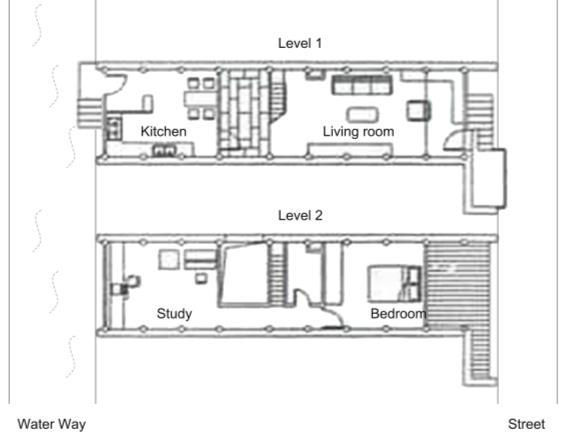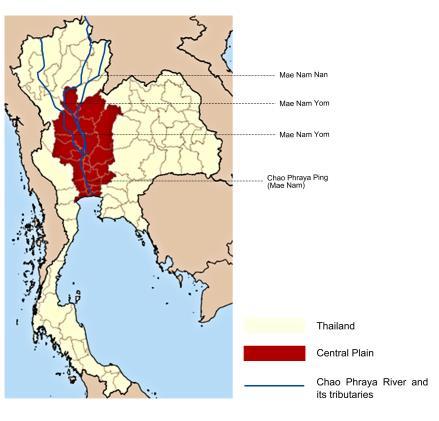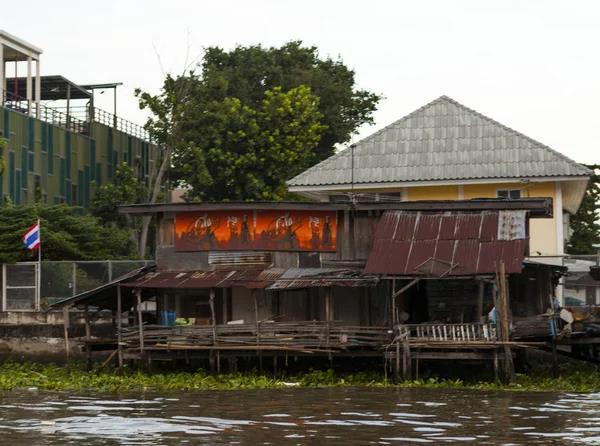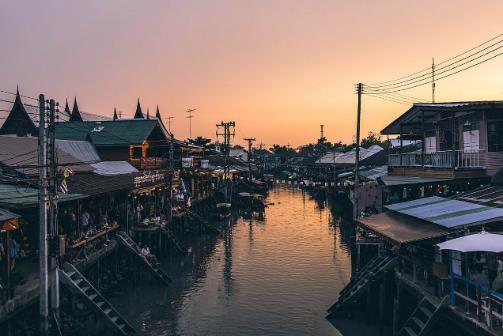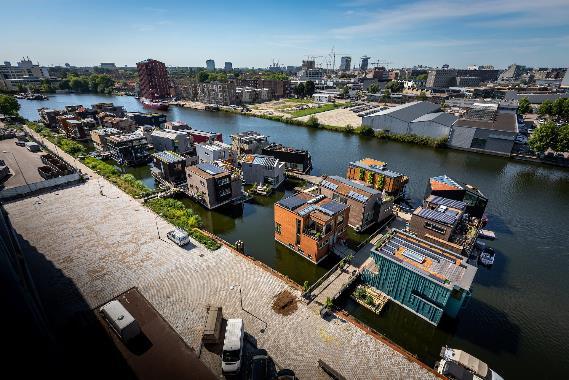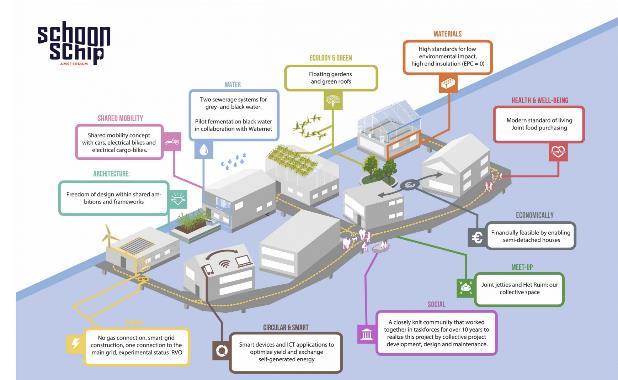1 Introduction
1.1 Research background
Water,asoneofthemostcommonlifesupportfactorsintheworld,hasalsoplayed animportantroleinthecourseofhumanhistoryratherthanmerelyactasa materialsubstanceorgeographicalelement.Jiangnanregionhastherichestand mostwidelydistributedareaofwaterresourcesinChina,itsaffinitywithwatercan betracedbacktotheHemuduculturewhichexisted6,000to7,000yearsago.Just asProfessorYangJianhuaoftheZhejiangAcademyofSocialSciencessaid,1 dueto thegeographicallocationandclimaticcharacteristics,waterhashadaprofound impactonthesociety,cultureandlifeofJiangnan,therefore,itisviewedasaclassic symbol.Asidefromitssymbolicandspiritualsignificance,wateralsoplaysavital roleinprovidingmaterialandfunctionalsupport.Duetotheregion'sadvantageous geographicalconditionsandabundantnaturalresources,localpeoplerelyonwater inalmosteveryaspectoftheirdailylives,includingthesitingofsettlement,the watertransportation(Fig.1)andeventhemaintenanceofdailylife,likethe acquisitionoffood,thegenerationoffamilyincome,thetradeineveryday necessities(Fig.2)andsoon.Asaresult,JiangnanWaterTownemergesasa settlementcharacterizedbyitstypicaleconomicdevelopmentmodeandsocial constructionlogicdependingonwater.
1 “Harmony of Softness and Strength: Why Water is the Soul of Jiangnan Culture ” , CCTVNews , July 3, 2020, https://news.cctv.com/2020/07/03/ART19XfsROk7SZzHCnfLDn200703.shtml
conditions.AccordingtoFeng,3 duetothedensewaternetworkandmunicipal prosperity,thehouselandinJiangnanWaterTowniscomparativelynarrow.The streetsarebuiltalongtheriver,andthelayoutofthebuildingfollowsthedirection ofthestreets,whichresultsinthesettlementtobedescribedasanarrow,strip-like formarrangedalongtheriver.4
What’smore,lookingatthearchitecturalunititself,it’salsoveryclearthatmanyof itsimportantelementsreflecttheuseofwaterbyitsresidentsintheirdailylives. Forexample,tobettergetaccesstothewater,almosteveryhouseinJiangnan WaterTownshasanindependentwaterfrontterracespacewhichisconnectedto theshorebystonestepsandcalledas“ShuiBuTou”(水埠头) 5 (Fig.3)Itiseither directlyconnectsthebuildingtothewateratthebackdoororcorrespondstothe frontdooracrossthestreetandmanydailyactivitiestakeplacehere.Likewise,the functionallayoutofvernacularresidencealsoreflectstheresidents'extraordinary wisdomintakingadvantageofnature.AsobservedbyYang&Shi,6 althoughthere iscertainflexibilityintheinteriorlayouttoaccommodatethecurvingriver,their specificfunctionalarrangementgenerallyfollowsoneprinciple:placingprivate andfrequentlyusedrooms,awayfromthewater,andpubliconesnotsosensitive tomoistureareplacedclosetowater(Fig.4).Onlyinthiswaycanpeoplemakeuse
3 Daogang Feng, ResearchontheInteractionBetweenSpatialFormsandBehaviorinAncientWaterTownsof Jiangnan(Master’s thesis, Jiangnan University, Design Art, 2006).
4 Yingqian, Yu. "Discussion on the Regional Cultural Characteristics of Jiangnan Dwellings," Building Development5, no. 1 (2021): 33–34, https://doi.org/10.12238/bd.v5i1.3640
5 Yang and Shi, "Layout Characteristics of Jiangnan Waterside Residences," 2.
6 Yang and Shi, "Layout Characteristics of Jiangnan Waterside Residences," 2.
ofthehighspecificheatcapacityofwatertocreateawarmerwinterandcooler summerenvironment.7
Figure 3. Shui Bu Tou: steps heading to water Figure 4. Common interior layout of residence (Source: https://images.app.goo.gl/8DFJYxvXbYjkH81P9) (Source: Xinhong Xu, Urban Water Systems and the Inheritance of Urban Characteristics: A Case Study of Jiangnan Cities (Master’s thesis, Southeast University, 2006), 76. + edited by author)
Inviewofthepreviousstatement,itisfairtoconcludethatwhendefiningand recognizingthevernaculararchitecturalcharacteristicsofJiangnanwatertownas wellasthereasonsforitsprosperity,peopleandwaterareallindispensable elements.However,moderneconomical,technologicalandindustrial developmentshavegraduallyreducedthedecisiveinfluenceofthesetwofactors. AccordingtoRuietal,8 thenetpopulationlossrateintraditionalvillages nationwidehasreached78.74%.AsoneofthemostimportantJiangnanwater townclusters,Jiangsuisalsoexperiencingsuchtrend:accordingtoChina’sSeventh NationalPopulationCensus,Jiangsu’sruralpopulationhasdecreasedby8.784
7 Yumeng, Huang, “Study on Traditional Settlement Environment and Layout in Jiangnan from the Perspective of Water Body: Take Tongli Ancient Town as an Example,” RegionalArchitecturalCulture194 (2020): 05.
8 Rui Yang, Tao Jin, Jingyi Lin, Kun Yang, and Yifeng Li, “Spatial Identification and Formation Mechanism of Population Outflow Field of Chinese Traditional Villages: Based on the Fourth and Fifth Batches of National Traditional Villages,” GeographicalResearch42, no. 5 (2023): 1248–1266, https://doi.org/10.11821/dlyj020220733
million,whileitsurbanizationratehasincreasedby13.22%.Anothernegative influenceisthegentrificationoftraditionalspaces.Accordingtostatistics,around 400millionemergingmiddle-classindividualshaveappearedacrossthecountry, makingupapproximately30%ofthetotalpopulation.9 Theirboomingcultural andspiritualdemandshaveledtoalarge-scaleexpansionofthetourismindustry basedontraditionalcultureandscenery,whichhasleadedtotheencroachmenton theeverydaylivingspacesoftraditionalneighborhoods,thuspushingthelocalsto moveaway.Thedisplacementoflocalresidentshasledtotheabandonmentof manyoldvernacularhouses,andrapidexpansionoftourismtendstoreshape differentJiangnanWaterTownsintoformulaicculturalzones.Consequently, numerousvernacularsettlementshavelostboththeirauthenticityandthe potentialforfuturesustainabledevelopment Atthesametime,water,whichonce servedasaprimarytransportationrouteandavitalsupportfordailylife,hasgiven waytoroadsandgraduallybecomeadecorativeelementprimarilyforlandscape purposes.Becauseofthese,theconnectionbetweenpeopleandwaterinJiangnan WaterTownaccumulatedoveralongperiodoftimeisfadingaway,resultingthe lossofthebasisforthepersistingoftraditionalvernaculararchitecturethere. Althoughrelevantauthoritieshavetosomeextentrecognizedtheexistingproblem, theirapproachesremainrelativelystraightforwardwhichfirmlyadheretothetop-
9 Lu Song, Chen Luqiao, Long Cheng, and Duan Pengxiao. "Research on Gentrification of Traditional Village and Town Tourism in Suburbs of China's Large Cities A Case Study of Zhujiajiao Ancient Town in Shanghai." ActaGeographicaSinica78, no. 10 (October 2023): 2535-2552.
downconservationlogicandarehighlypossibletocauseformalismanda disconnectionwiththedailylivesofusers.Undoubtedly,suchsituationhasavery negativeimpactontheconservationofJiangnanvernaculararchitecture,whichisa maturearchitecturalprototypecontinuouslyevolvedthroughouthistory10 with higharchitectural,socialandculturalvaluessinceitdisrupteditslong-established growthlogic.
1.2 Literature review
Therehavealreadybeengreatamountsofresearchesfocusedonvalidatingthat theprosperityofJiangnanWaterTownisfullydependentonitssuperior geographicalenvironmentandnaturalresourcesaswellasitsindigenousresidents withprofoundlifewisdom.Andthevernaculararchitecturethereisthebest showcaseofthecooperationbetweennaturalandhumanisticfactors,sinceasthe mostimportantfoundationforpeople'slivelihoodintraditionalfarmingsocieties, architecturehasaverydirectrecordanddemonstrationofhowpeoplehavelived throughouthistoryandthewaysinwhichpeoplehaveusednaturetooptimize theirlives.AmongallthenaturalresourcesinJiangnanWaterTowns,nodoubtthat waterhasalwaysbeenmostcloselyassociatedwithhumanbeings.Thisreview aimstosummarizeandcriticallyassessthemultipledimensionsofhuman-waterarchitectureconnectionsandinteractionsthathavebeendiscoveredaswellasthe
10 Wuxuan Zheng, ResearchonthePreservationStrategyoftheWaterTownCharacteristicsinSmallTownsof SouthernJiangsu:ACaseStudyofWujiangZoudouTown(master's thesis, Suzhou University of Science and Technology, 2016).
currentpracticeofcontinuingtotranslatesuchconnectionsintolong-lasting vernaculararchitecturaldevelopmentmethods.Themaincontentwillbedivided intofoursections,includingreviewingtheexistingresearchresultsaboutphysical andmentalrelationsbetweenwaterandpeopleaswellasthecurrentcommonor innovativepracticesinarchitecturalconservationthathighlightthesignificantrole oftheserelationships,findingtheirlimitationsandattemptingtodevelopanew researchlogictobridgethegap.
1.2.1 The physical connection between water and people
Manyscholarshaveexploredthetopicofthemostintuitivephysicalconnection betweenwaterandpeople,especiallyaboutthespatialrelationshipbetweenwater andman-madeobject:architectureinJiangnanWaterTowns,whetherona regionalscaleoronanarchitecturalunitscale.
Fromthebroaderscale,thecontributionsmainlyfocusonthegenerativelogicof thespatialstructureofthewholeregionandtheclearcharacteristicsofsettlement development.Firstofall,accordingtoXu,11 thereisapositivelinkagebetween urbanframeworkandthewaternetworkintermsofspatialmorphology,asthe latterdominatesstreetdirectionanddistrictlayout.Andintermsofspatial functionallocation,thedensityandwidthoftheoverallwatercoursesarekey determinantsofthemainformatofindustryandnatureofservicesincertain
11 Jie Xu, ResearchonStrategiesforShapingtheWaterCityCharacteristicsintheJiangnanWaterNetwork Area:ACaseStudyofSuzhou(Master's thesis, Suzhou University of Science and Technology, 2013).
area.12 Secondly,inJiangnanregion,theorientationoftheentiresettlementaswell asthescaleanddegreeofprosperityofthepopulationclustersarealsodetermined bywater.TheoverallshapeofresidentialsettlementsinJiangnantakestheformof anelongatedstrip,followingtheapproximatedirectionofthewaterwayand reflectsthegenerativelogicbehindwaterandtowns.13 Andaccordingtothe researchbyHuang,14 thetownsandvillagesbuiltattheconfluenceofmultiple streamsarelargerinscaleandhavemoreopportunitiesfordevelopment.
Fromthemicroscale,thespatialdivisionandfunctionalarrangementfromthe exteriortotheinteriorofthevernaculararchitectureallreflectpeople’smasteryof water.AsHuangobserved,15 thetraditionalhousesinJiangnanWaterTownsare generallybuiltperpendiculartotheriverswithnarrowfaçadeandlongdepth, whichensuresmorehouseholdstohaveequitableaccesstowaterresources.In addition,complementaryarchitecturalelementsoutsidethearchitecturesuchas barges,verandahs,stonebalustradesandriverpiersconnectthewateralleys,the landandthehousestohelppeopleusewaterandrelatedlandscapeeasilyand safely.16 Whenitcomestotheinteriorspatialarrangement,roomsthatarehighly utilizedandmoreeasilyaffectedbymoisture,suchasbedrooms,willbeplaced awayfromwater,whileroomsthatarerelativelylessutilizedandlessaffectedby
12 Xinhong Xu, UrbanWaterSystemsandtheInheritanceofUrbanCharacteristics:ACaseStudyofJiangnan Cities(Master’s thesis, Southeast University, 2006)
13 Yu, "Discussion on the Regional Cultural Characteristics of Jiangnan Dwellings," 33.
14 Huang, “Study on Traditional Settlement Environment and Layout in Jiangnan from the Perspective of Water Body: Take Tongli Ancient Town as an Example,” 247.
15 Ibid.
16 Zheng, ResearchonthePreservationStrategy , 2016.
moisture,suchaskitchensandbathrooms,willbeplacedasclosetowateras possible,soastofacilitatedailylifeinaspectsincludingfetchingwaterfor domesticuse,carryingoutwatertransactionsandsoon.17
1.2.2
The historical spiritual relation between water and people
Besidesthephysicalaspects,manyexpertshavealsosuggestedthatwaterin JiangnanWaterTownshaslongbeencloselyrelatedtothespiritualformationof localresidents.JustasFengproposed,18 Jiangnan’sabundantwaterresourceshave notonlybroughtrichproductsandaprosperous,leisurelylifestylebutalso nurturedaliteraticulturethatvaluesfreedomandidealism,withfewconstraints fromtraditionalrituals.ThishasshapedtheJiangnanresidents’fluidand unrestrainedtemperament,alongwiththeiropen-mindedandinclusivewayof life,19 whichlaysthefoundationfortheregion’suniquespiritualandcultural identity. Whileexistingstudiesprovidevaluableinsightsintothephysicalandspiritual relationshipsbetweenpeopleandwaterrevealedthroughthearchitecturaldesign andlivingconditionsinJiangnanregion,theyoftenoverlookthefactthatmostof suchrelationshipshappenedinthepast.Withthechangesinpeople'slifestylesand
17 Yang and Shi, "Layout Characteristics," 2016.
18 Feng, ResearchontheInteractionBetweenSpatialFormsandBehaviorinAncientWaterTownsofJiangnan, 2006.
19 Weiming Cao, “Cultural Jiangnan The Wisdom of ‘Being Like Water,’” ShangguanNews , July 23, 2024, https://www.163.com/dy/article/J7QIFT1V055040N3.html
waterscaperesortinWuzhenwestgate,thewaterfrontvillasandcommercialareas alongsideculturaltourisminZhujiajiaoaswellasthehomogenizednewwater townscharacterizedby“Smallbridge,murmuringstreamandhomesinserenity” inalmosteverywhereinJiangnan.21 LeiandZhangconcludedthatsuchmethods actuallyfollowthe“TourismGeographyTheory”22 thatemphasizethe multidimensionaluseoftheuniquenaturalresourcesandgeographicalfeaturesof thedestinationsfortourismdevelopment,whilepromotinglocaleconomicand culturaldevelopment. Unfortunately,thesepracticesdonotreallyfitwiththethesisofthisdissertation sincetheirconsiderationsareparochialintermsofthebeneficiarygroupsandthe long-termsustainabilitysinceallofthemimplytherelinquishmentoftraditional landusagerightsandthedisappearanceofthefoundationforplacedevelopment. Moreresearchesshouldbedonetobalancetheappropriationofthenew economiesespeciallythosebroughtaboutbytourismandtheprotectionof traditionalresidentsplustheirrightstoliveaccordingtotraditionallifestylesin theiroriginalplacesofresidence.
1.2.4 Initial practice in emphasizing human-nature interaction
Recently,thereisagrowingbodyofliteratureexaminingthepossibilityofmaking
21 Zheng, ResearchonthePreservationStrategy , 2016.
22 Yunyao, Lei and Qiongfang Zhang, “Analysis of Character Convergence of Jiangnan Ancient Towns.” In Proceedingsofthe2016InternationalForumonManagement,EducationandInformationTechnology Application , 939-944. 2016. https://doi.org/10.2991/ifmeita-16.2016.172
useoftheinteractionbetween“true”natureand“true”people(localresidents)to activatethewatertowns.Forexample,XitangAncientTown,whichsetthe developmentfocusonimprovingthelocallivingenvironmentincludingwater qualityandpromotingagriculturalleisureactivities;PingjiangRoad,which organizescommercialforms,continuestraditionalcommerce,andpreservesthe appearanceofmostresidentialbuildings……Theyattempttointegratetraditional landscapes,historicalcontext,culturalsignificance,andmemoriesoflocallifeinto thenewurbansociety,andusetheseasdrivingforcesforfuturedevelopment.23
Nodoubtthatthesepracticesaresomewhateffectiveforbalancingtheneedsof localresidentstomaintaintheirwayoflifewiththedesiresoftouriststoseekfor relaxationandauthenticexperiences.However,theyarealljustpreliminary attempts,andtheprocessisrelativelyidealized,lackingverificationovertime. Therefore,furtherinvestigationisneededtoprovethelong-termeffectivenessof theseactionsandimprovementsshouldbeupdatedbyanalyzingandreconciling theconflictingperceptionsofstakeholdersanduncoveringcommonalitiesinthe useandappreciationofwaterbydifferentpeople.
1.3 Research questions
Inviewofthecurrentdevelopmenttrendsinmodernsociety,socialprogressis
23 Li Zhen, "A Comparative Study of the Government-led Operation Mode for Vernacular Architecture Heritage Protection Management: A Case Study of Suzhou Pingjiang Historical District and Xitang Ancient Town in Jiangnan Water Town," SouthArchitecture , June 2011, http://lib.cqvip.com/Qikan/Article/Detail?id=41112990&from=Qikan_Search_Index
tensionsbetweenthesefactorsandsustainabilitybereconciled?
Additionally,itisalsocriticaltothinkaboutwhataretheoperationalprinciples thatcanhelpthetargettobeachievedstepbystep?
1.4
Research scope and methodology
Inthisdissertation,thetargetresearchareaisJiangnan,whichcanberoughly definedastheregionsouthofthelowerreachesoftheYangtzeRiver,including Zhejiang,southernJiangsu,southernAnhui,andthecentralandnorthernpartsof FujianwithdensewaternetworksoriginatingfromYangtzeRiver,QiantangRiver, theGrandCanalandTaiLake.24 Togainadeeperunderstandingofthe characteristicsandvaluesoftraditionalvernaculararchitectureinJiangnanWater Townandformmorereasonableconservationmethodsbasedonthem,theauthor willincluderesearchesonboththeregionalscaleandmonolithicbuildingscale, andatthesametimefocusontherelationshipbetweenthesetwo.
Inordertogainamorecompleteandobjectiveunderstandingofthecurrent developmentprocessofvernaculararchitectureintheJiangnanWaterTownsand toassessthefeasibilityofusingtherelationshipbetweenthehumanitiesandwater asaguidingprincipleforhumanisticconservation,methodsincludingpolicy research,theoreticalresearch,casestudiesandcomparisonsbetweenJiangnan
24 Zheng, ResearchonthePreservationStrategy , 2016.
WatertownsinChinaandtheCanalDistrictinAmsterdamaswellastheriverine settlementsinthecentralplainofThailandwillbeusedforexplorationand argumentation.
1.5 Research significance
Thisresearchcontributestofindingthepossiblewaytosustainablydevelop JiangnanWatertownandseamlesslyintegratethistraditionalregionintoamodern contextbypushingforresearchesontherelationshipbetweenhumansandwater, alongwiththetransformationofthisrelationshipforthehumanized,rationaluse ofwaterspacesunderthethreatposedbyurbanization,tourism,gentrificationof spacesandsoon
2 Policy Research
ConsideringthattheChinesearchitecturalconservationfollowsthe“top-down” principle,itisnecessarytoregardthestudyongovernmentpoliciesandsupportas thefirststepinthefeasibilitystudyphasebeforeimplementingnewconservation concepts.
2.1 Attitudes and treatments towards water
Tounderstandtheofficialstrategicpositioningofwaterinurbandevelopmentand assesstheextenttowhichexistingregulationsinterprettheinteractionbetween people,water,andtraditionalarchitectureinJiangnanWaterTowns,theauthorhas
specificallystudiedthedocumentsissuedbythegovernmentsofthemajorcities andregionswheretheJiangnanWaterTownsarepredominantlydistributed, includingSuzhou,Wuxi,Jiaxing,andShanghaiPudongNewArea,titled "RegulationsontheConservationofAncientWaterTownsinJiangnan".25262728 Withoutexception,allthemunicipalgovernmentshighlightthenecessityof advancingecologicalcivilization,withparticularemphasisonthecomprehensive managementofriverandlakesystems.Thespecificpracticesincludethe maintenanceanddredgingofwaterways,restrictionsonunnecessaryland reclamationaswellasstrictcontroloverpollutionsources,whichcaneffectively helppreservetheoverallqualityofaquaticenvironmentsareverygoodstartsof optimizingJiangnanWaterTowns.
Thedocumentscollectivelyindicateagrowinggovernmentalawarenessthatwater playsavitalroleinboththearchitectureanddailylifeinJiangnanWaterTowns andsuchunderstandinghasalreadybeenreflectedintheguidingprinciplesof ecologicalgovernance.However,aspreviouslymentioned,waterisnotlimitedtoa materialsubstanceorageographicalentity,instead,italsocarriesbothsocialand spiritualsignificance Butalmostalltheapproachesfocusprimarilyonaddressing
25 Suzhou Municipal People's Government, RegulationsontheConservationofJiangnanWaterTownsin Suzhou , issued 2018, https://www.suzhou.gov.cn/szsrmzf/szfgzk/202111/cf6fb75726894438becc23c82bcc6a70.shtml
26 Wuxi Municipal People's Government, RegulationsontheConservationofJiangnanWaterTownsinWuxi, issued 2021, https://www.wuxi.gov.cn/doc/2021/12/23/3606540.shtml
27 Jiaxing Municipal People's Government, RegulationsontheConservationofJiangnanWaterTownsin Jiaxing,issued 2020, https://www.jiaxing.gov.cn/art/2020/5/15/art_1229426365_1874284.html
28 Pudong New Area People's Government, RegulationsontheConservationofJiangnanWaterTownsin PudongNewArea,issued 2023, https://www.pudong.gov.cn/zwgk/gfxwj-qzfzcwj/2023/254/316309.html
issuesatthemateriallevel.Inthedocuments,watertreatmentisalwaysclassified tothecategoryof‘environmentalmanagement’andthemaintargetistoensureits cleanlinessandecologicallysustainability,withlittleconsiderationgiventothe socialinteractionandculturalrenovationcenteredonwater.Inthiscontext,water remainsapassivenaturalelementandsymbolicfeatureratherthananactive participantinmodernlife,soitcannotbeleadedtofunctionefficientlyasamedia whichhelptorestoretheoriginalwater-centeredcommercial,recreational,and dailyactivities,aswellastheuniquespatialexperiences.Preciselybecauseofthe disconnectionwiththebehavioralbasis,thespiritualresonanceofpeople's collectivememoryoflifebythewaterinJiangnanWaterTownsisalsodifficultto awaken.Moreover,itshouldbenotedthatwater,whenpresentedasavisual element,oftendoesnotprimarilyservetheneedsoflocalresidents Onthe contrary,itwillbeinstrumentalizedasacomponentoficoniclandscapespaces aimedatattractingtourists.Underthissituation,thelong-lastingvernacular characterofwaterwillsoonbegentrifiedandturnsouttobe“stagedauthenticity”, justascriticizedbyDavidVarady.29
Peoplecannotperceivetheworldbysightalone,norshouldwaterbereducedtoa leisure-orientedlandscapeelement Therefore,itisfairtosaythatcurrentwater conservationmeasuresstressedbythegovernmentaretoosuperficialand
29 David Varady, "Amsterdam’s Canal District: Origins, Evolution, and Future Prospects, by Jan Nijman (ed.), Toronto: University of Toronto Press, 2020," ResearchGate , 2021, https://www.researchgate.net/publication/349188083_Amsterdam's_Canal_District_Origins_evolution_and_futu re_prospects_by_Jan_Nijman_ed_Toronto_University_of_Toronto_Press_2020
dehumanizingtodefinethesignificanceofwaterspacesasmerescenicattractions withoutexploringitsvalueswhenextendedtothelocalpeople’sdailyactivities.
2.2 Conservation of waterways within a designated area
WatersystemsoccupyasignificantportionoflandintheJiangnanregion.However, duringtheprocessofmodernization,manywaterwaysweresacrificedforthe replanningofnewtrafficsystems.GiventhatJiangnanWaterTownsarefully dependentonthesewaterways,theirrestorationisofgreatimportance.Asstated byShanghaiPudongNewAreaGovernment,effortstorestoreandconserveriver andlakesystemsshouldbeconcentratedmainlywithinthedesignatedheritage corezonesandbufferzonestoensurethecontinuityandfunctionalityofthewater environmentwithgreatesthistoricalandsocialvalues.30 However,thewater systemsinJiangnanareinterconnectedandcontinuous,ratherthanisolatedor stagnant,andpreciselybecauseofsuchcontinuitythattheeconomic,culturaland socialcommunicationbetweentheJiangnansettlementscanbeestablished.
Althoughselectiveconservationcanproduceshort-termbenefits,itfundamentally disruptsthehistoricaldevelopmentlogicofJiangnanWaterTowns,whichis intrinsicallytiedtothecontinuouswaterflow.Asaresult,suchpracticedoesnot conformtotheprincipleofauthenticityinthelongrunandwillfacemore problemsifthosewaterwaysoutsidetheconservationareadeterioratefurtherin thefuture Suchsituationrevealsthatundercurrentpolicy,theproblemof disruptedwaterconnectivitycausedbyurbanizationcannotbefullyresolved.
30 Pudong New Area People's Government, RegulationsontheConservation , 2023.
2.3 Different attitudes towards historical and common architecture
Inrecentyears,ruraldevelopmenthasbeenamajorfocusoftheChinese government,whichhaspushedfortheimplementationofpoliciesrelatedto conservingvernaculararchitecture.Inthe Opinions on Strengthening the Protection and Inheritance of Historical and Cultural Heritage in Urban and Rural Development, numerousclausesstrengthentheimportanceofavoidingexcessivedemolition, makingrationaluseofvernacularbuildingsespeciallythosehistoricalonesand industrialheritagestopromoteconservationthroughutilization,andincorporating heritagesintotheoverallruraldevelopmentprocess.31 Unfortunately,these regulationscaremoreaboutthosebuildingsofprominenthistoricalsignificance locatedinkeyareasandlittleattentionhasbeenpaidtothoseordinarybuildings suchasresidentialdwellings However,thevastmajorityoftraditionalbuildingsin JiangnanWaterTownsareresidentialdwellings,makingitdifficulttoassesstheir significancesfromthepublic’spointofview,therefore,lesstreatmenthasbeen donetooptimizethem.However,forindividuals,thesetraditionalresidencescarry thelifememoriesofthemselvesandtheirfamiliesandrepresentthemostsecular reflectionofthelocalculture,sotheirimportanceshouldnotbeoverlooked.
Toconclude,therearestillmanygapsinthecurrentpolicystructuretohelp conserveJiangnanWaterTowns,andfillingthesegapsrequirescollaborative
31 General Office of the CPC Central Committee and General Office of the State Council. Opinionson StrengtheningtheProtectionandInheritanceofHistoricalandCulturalHeritageinUrbanandRural Development.GazetteoftheStateCouncilofthePeople’sRepublicofChina , no. 26 (2021). Accessed April 13, 2025. https://www.gov.cn/gongbao/content/2021/content_5637945.htm
factors.
3.1 Elaboration of theory
Thefundamentalaimofconservingvernacularbuildingsistooptimizethesitesso thattheycanbeusedbymorepeopleinthelongterm,thus,theconservation processshouldfollowtheprincipleof“humanizingtheplace”.Unliketheoverdevelopmentoftourismandover-emphasisoneconomicgains,suchconservation logicrepresentsahuman-centeredsocialvaluethatstrengthenshumanconcern, humandignityandtheexpressionofhumanself-worth.34 Itsspecificcontentcan bedividedintofouraspects:
3.1.1 Paying attention to human living environment
Itconcentratesonthecleanlinessandcomfortoftheirlivingenvironment.In JiangnanWaterTowns,thiswillbemorerelatedtotreatmentofwaterpollution andrestorationofaquaticecosystems.Conservationistsshouldtakeresponsibility formaintainingtheecologicalstabilityofwaterinasustainablemanner.Previous policyresearchindicatesthatthisrequirementhasalreadyraisedgreatattention inthemajorityofregionswhereJiangnanWaterTownsarelocated.
3.1.2 Focusing on the exploration of regional culture
34 Mengdi Yang. and Yihua Zeng, "Urban Design Strategies of the New Town in Jiangnan Water Town from a Humanistic Perspective: A Case Study of the New Town of Zhenze Town." UrbanArchitecture , 2016. Accessed February 23, 2025. https://doc.taixueshu.com/journal/20164053csjz
Inadditiontothemaintenanceofthenaturalenvironment,thepotentialofthe humanenvironmentalsoneedstobeexplored.Onlybyensuringpeople's attachmenttoandfirmidentificationwiththeuniquecultureofeachregioncan theypromotethesustainabledevelopmentofregionalculture,avoidtemplated transformationsandrealizetheharmoniouscoexistenceofhistoryandthepresent.
3.1.3 Paying attention to the construction of spiritual space for humans
Meetingpeople'sbehavioralandpsychologicalneedsshouldbethebasicpursuitof architecturalexpressionandspatialarrangement,butcurrentstatusquoisalack ofandclutteredpublicspace,35 andmostofindoorspacesfollowtheprinciplesof standardizationandpracticalityinthecontextofmodernindustrialization 36 Therefore,moreattentionshouldbepaidtopreservethehabitatofpeople's spiritualcivilizationwhichcannotbeachievedwithmoreformalizedandlifeless culturalmemorials.
3.1.4 Focusing on issues concerning human well-being
Theadvancementoftechnologyandthedevelopmentofsocietyhaveundeniably improvementonhumanlife,whilethetraditionalwatertownenvironmentand vernaculararchitecturealsohavetheiruniqueadvantagesbylettingpeopleget awayfromthehustleandbustleofthecityandenjoyapeacefulcountrysidelife.As
35 Ibid.
36 Yuhuan Cai, “On the Protection and Development of Huizhou Architecture: Inspirations from Venice,” JournalofHuangshanUniversity21, no. 2 (2019): 66-69
aresult,itisimpossibletorejectdevelopment,andneitherisaconservationmode thatfixestheoldastheoldacceptable.Thepreferablewayshouldbeareasonable implantationofmoderntechnologicalmodificationswithoutdestroyingtheorder ofthehistoricenvironment.37
3.2
How to assess
3.2.1
Fairness
Everyparticipantsofthespaceshouldhavefairuseofit,ratherthanjust consideringwhetherpeople'susewillhaveaneconomicvalue.ForJiangnanWater Town,thetruebuildersandrightfulownersarethegenerationsoflocalswhohave livedonthislandforcenturies.Therefore,whenconsideringaboutthefuture functionsofitsarchitectureandtheserviceobjectofitswaterresources,thefocus shouldnotbesolelyontheshort-termbenefitsbroughtbytouristsbutratheron thelong-termdedicationanddeepemotionalattachmentofthelocalresidents.
Onlyinthiswaycanthetownsustainitshistoryandescapefrombeingalienated intoacommodity.
3.2.2
Convenience and safety
Whentreatingaheritagesite,blindlyclingingtotheoldisoverlyrigidandpedantic sincethepremiseforpeopletoremaininacertainplaceisthatitcansupport people'sbasiclives.Aplaceneedstohaveafutureratherthanbeingburiedinthe
37 Ibid.
3.3.1 Shared use by aboriginal people and tourists
Animportantwayofresolvingtheconflictbetweenmaterialandemotionalaspects intheprocessofconservationisadvocatingequalemphasisonbothofthem.
Aboriginalpeoplehavebeenconstructingandshapingthislandforgenerations,so theyknowitbest.Inaddition,althoughoutsidetouristsonlyexperiencethisspace forashortperiodoftime,theireconomiccontributionsaresubstantialand concentrated,layingamaterialfoundationforitsfuturedevelopment.Therefore, onlybyintegratingthebenefitstheybringtothislandcanitslong-termand sustainabledevelopmentbeensured.
3.3.2 Help from environmental psychology and environmental behavior studies
Althoughtheprevioustextemphasizestheutilizationofwaterbyhumansandthe influenceofwateronpeople,itis,infact,areciprocalprocess.Theresearchers shouldalsoconsiderwhatpeople’sthoughtsandbehaviorscanbringtothe environmentandwhydoesthecontinuationofwaterandthehealthof environmentalsorequirehumaninterventiontosustain.Suchabidirectional understandingcandeepentherelationshipbetweenpeopleandwater,thusfurther demonstratethevitalroleofhumanparticipationintheconservationofwaterand itsrelatedenvironmentalfactors.
3.3.3 Unleash the creativity of users
AsstatedbyFengDaogang,“Asuccessfulspacemusthaveastrongsenseoflife”,38 otherwise,itwillloseitsvitalityofgrowth.Asaparticipantinthepubliclifeofa space,everyonehastheabilitytocontributetoitslong-termflourishing.As leaders,whethertheyaregovernmentofficialsormembersofnon-governmental organizations,shouldhelpdefinetheroleofeveryindividualintheconservation processandletthemrealizethattheirideasmatterandtheirneedsareseen.
3.4 Obstacles
3.4.1 Dispute over rights and interests
Differentstakeholdershavedifferentvaluesystemstowardsarchitecturalheritage. Thisismainlyreflectedintheconflictoflandrights:merchantsandtouristswill benefitiftheheritagesiteisturnedintoaleisurefacilitylikepremiumresort,but localpeoplewilllosetheirhomeland;localresidentswillbenefitifthespacecanbe improvedintoanewcommunitywithalltheamenitiesandsharedby acquaintances,buttouristswilllackaplatformtoenjoytheview,etc.
3.4.2 Irreversible damage
ThevernaculararchitectureinJiangnanwatertownshassufferedalotof irreparabledamageduetolarge-scaledemolitionandsuperficialmake-up.Inthe earlydaysofChina'sreformandopeningup,urbanconstructionfolloweda“ mass demolitionandlarge-scaleconstruction”approach,andarchitecturalconservation
38 Feng, ResearchontheInteractionBetweenSpatialFormsandBehaviorinAncientWaterTownsofJiangnan
atthattimewasmoreconcernedwithvisualimitationandneatness.Hence,agreat amountoftheJiangnanWaterTownshasalreadybeendemolishedtomakewayfor modernbuildingsortransportsystems.Andmanyofthesurvivorshavealsohad theirauthenticityandintegritydestroyedbytheirreversibleattachmentofwrong materialsandroughrepair.
3.4.3 Weak participation and motivation
Themotivationoftheoriginallocalpeopletorenovatethetraditionalwatertown togetherisweakduetotherealitythatthetraditionalbeautyofvicissitudesand theprimitivewayoflifearenoteasytobewidelyrecognizedbythelocal residents 39 Fromtheirperspective,thereisasimplerandquickerwaytoaccessa moreefficientandmodernlife,thatismovingoutofthecountrysidetothemodern city. Theseobstaclesareaninevitablepartoftheexploringprocess,andit'sunfairto criticizethem,astheyservetotestthefeasibilityofaconservationplan,onlywhen theyareproperlysolvedcantheplanbedefinedasreliable.Allaroundtheworld, therearemanytraditionalcitiesbuiltalongwater,andtheirexperiencesmayhelp totestthenecessityofputtingthetheoryof“humanizingthespace ”intopractice andoffervaluableinsightsforaddressingtheseobstaclesfacedbyChina.
39 Youling Wang, Xi Fan, Xiaozhou Su, Hongyi Wei, Yiquan Ding, and Han Gao, “Protecting China’s Traditional Villages: Keeping Nostalgia Rooted in the Land,” LegalSystemandSociety , no. 12 (2023): 30–33, https://doi.org/10.3969/j.issn.1009-0592.2023.12.011
thoseresidentsoflargeneighboringcities.
5.
(Source: https://images.app.goo.gl/kQZC9YBdpK8JoHgJ9) (Source: https://images.app.goo.gl/MiCPEX2ggbMw7942A)
Suchdistinctiveandvibrantlandscapesundoubtedlybecameculturallandmarks andkeyelementsinthepromotionoftourisminBangkokduringthemid-to-late 20thcentury,attractingcountlessvisitorsfromaroundtheworld.41 However, unlikethemeasurestakeninChina,Thailanddidnotrelocateitslocalpeopleto makewayfortourism.Onthecontrary,theidentityoftheresidentswas maintainedandevenbecamemoreclearlydefinedandformalizedintheprocessof developingvisualrepresentationsfortourism.42
4.1.2 Valuable architectural conservation practices
IntraditionalThaisociety,toimproveventilation,heatdissipation,andmoisture drainageefficiency,peopledevelopedstilthouse,atypicaltropicalarchitectural typologycomprisingamainhouse,veranda,andterracefeaturedfullyenclosed,
41 Teeraporn Thongpanya, “Damnoen Saduak Floating Market: The Construction of Floating Market Community Identity from Agricultural Society to Tourism Community,” KasetsartJournalofSocialSciences39 (2018): 254–261, accessed April 9, 2025, http://www.elsevier.com/locate/kjss
42 Ibid.
Figure
Thailand waterways
Figure 6. Amphibious architecture in Thailand
semi-open,andfullyopen.Theoverallstructureissupportedabovewaterby woodenorbamboostilts,anddifferentpartsofthestructureservesdifferentlyin dailylifeaccordingtovaryingdegreesofprivacy.Amongthem,theterracewhichis fullyopenandclosesttothewaterisanidealspaceforsocialinteractions,among whichtradeisaprominentexample.43 Inthedailycontext,merchantstransported goodsalongthewaterwaysandstoppedinfrontofterraceswherethereare demands,conductingtransactionsdirectlywiththeresidents.Inanothercase, goodsweredisplayedonthemerchants’ownterracesforpassingboaterstoselect andpurchase(Fig.7).Undertheseconditions,theterraces,whileservingasdisplay platforms,alsofunctionedassemi-publicspacesfordiningandcommunication. Typically,theterraceisconnectedtothewaterbybigstepswhichalsoassume somepartsofitspublicfunctions(Fig.8) Suchadistinctivewayoflifeand economicpatternhasendowedthelocalpeoplewithaparticularsenseofidentity, onethatwasdeeplyintertwinedwithwaterandboats.
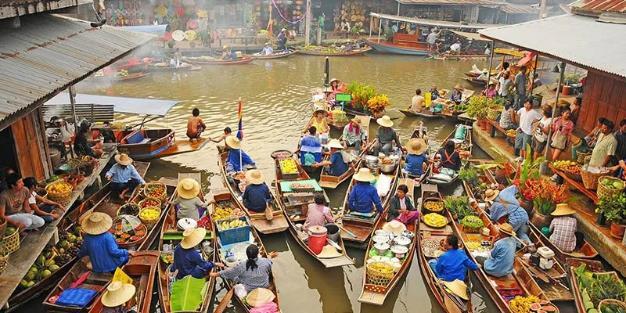
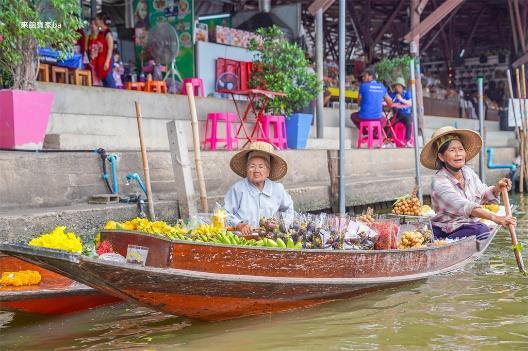
(Source: https://images.app.goo.gl/r35dZqnvYocUppuN8) (Source: https://images.app.goo.gl/HqK4bSTfbyEzoYj16)
Nowadays,althoughThailandisalsoundergoingmodernization,andthegrowthof
43 Kong, “A Study on the Waterside Landscape,” 166.
Figure 7. Business mode of floating market
Figure 8. Steps as public space
tourismhasinevitablyledtosomedegreeofresourceappropriation,yet,when facedwithsuchtraditionaleconomyandlifestylerootedinwatersidedwellings andfloatingmarkets,theThaigovernmentchoosestonotcarryoutatotal eliminationbutexpandtheirrelevance:theimageofboatsrowingtowardlocal residentshasbeenextendedtoincludetouristsaswell.Thatistosay,thecontent oftraditionallifeisremainedbuttheaudienceisbroadenedandsuchmodeof invitingtouriststoparticipateinthetraditionallifeactuallybecomeanimportant competitivepointforlocaldevelopment.
TaketheAmphawaFloatingMarket(Fig.9),whichisdefinedasthemostdaily-liferootedmarketlocatedwithinaclusterof19th centurybuildingsasanexample.It usedtobeanimportanttransportationandcommercialhubofSamutSongkhram province,44 lateron,drivenbydemand,itspontaneouslyformedakindof“market onappointment”,45 whichprovidedaplatformforlocalsandvendorsfromall provincestocongregateandtrade However,sincethemid-20thcentury,withthe developmentoflandtransportation,relianceonwaterwayshasdeclined,leadingto aperiodofdeclineandovertourismintraditionalfloatingmarket,andthe AmphawaFloatingMarketwasonceshutdown.Inordertoconservethe authenticityoftraditionalriversidedwellingsandmarkets,theThaigovernment
44 Thaiest, "Amphawa Floating Market," Thaiest , 2024, https://thaiest.com/blog/amphawa-floating-market
45 Chalermpat Pongajarn, René van der Duim, and Karin Peters, “Floating Markets in Thailand: Same, Same, but Different,” JournalofTourismandCulturalChange16, no. 2 (2016): 109–112, https://doi.org/10.1080/14766825.2016.1253704
implementedpoliciestopromotecommunity-basedtourism(CBT).46 Farfrom beingemptyrhetoric,theCBTplanwasverypracticalwithstraightforward implementationstrategiesandstructuredtimeline,andthemostimportantthing is,itaccuratelyidentifiedthecoreissuebehindthedecayoftraditionalareas:local populationloss,andaddresseditthroughhumanisticways.
(Source: https://images.app.goo.gl/PyCiZRTYddpTPZ9U7)
AccordingtoPongajarnetal, 47thespecificapproachesarephasedandmeticulous: intheshortterm,thegovernmentensuredlocalmerchants’basicincome(€7.5per day)andpurchasedtheunsoldgoodstoretainthelocalpeople.Then,overthe mediumterm,effortsweremadetobalancethefunctionsofthekeyfloating marketsfollowingthetraditionofthemarketofappointmenttoavoidcutthroat competitionandscheduletheopeningtimeofAmphawaFloatingMarketat weekendafternoonsandeveningstomeetlocals’needsoffamily-orientedleisure time.Inthelongrun,aspushedbythegovernment,thisareashouldtranscendits roleasapurelycommercialdistrictandtaketheroleofalivingopen-airmuseum
46 Ibid., 109.
47 Ibid., 116-117.
Figure 9. Amphawa floating market
toshowcaseitslocalcultureandreligiondatingbacktothepre-industrialeraby directlyengagingthetouriststothelocallife.Afterwards,althoughtherearesome disputesonthepropertyrightsofthewaterfrontspacesandthefloatingshops havechangedhandsseveraltimes,withpartofthemeventuallytakenoverby outsidemerchants,themainsocialdynamicsthemarketembodies:anorganic fusionoffloatingcommerceandwatersidetraditionalresidenceshasneverbeen lost.Themostimportantthingis,touristparticipation,whichislongdefinedasa negativefactortowardsarchitecturalconservation,hasinfactcontributedtothe morecomprehensiveandforward-lookingdevelopmentofthetraditionalsiteand ultimatelyencouragedthereturnoflocalresidents.
48
4.1.3 Inspiration: always in use
ThemainthemebehindtheenduringsuccessofThailand’sfloatingmarketsand thelong-lastingprosperityoftheresidentialhousesonwhichthosemarketsare basedliesinthecontinuousengagementbetweenlocalpeopleandwater.As proposedbyKongXianfa,thewaterinThailandisnotclearmirrorwhichis beautifulbutfragile,instead,itshouldmorebeseenasliquidgroundwithgreat economicandsocialattributesandfrequentlyusedbypeople.49 InThailand,ithas alreadyreachedaconsensusthatthecharmofthewatersideareaisinter-related withlocalcommunities,wheneveritisdetachedfromtheirdailylife,itwillloseits originalfunctionalityandparticularity,thenthescenesitshapeswilllosetheir
48 Ibid.
49 Kong, “A Study on the Waterside Landscape,” 165.
actualmeaning.Asaresult,notbeingdictatedbythetourists’highdemandfor site-seeing,Thailocalshavenevertreatedwaterasaseparatescenicelement,but trytofosteranewmodethatencouragetouriststousewaterjustasthelocalsdo andgivethemafirsthandexperienceoflocalculture,whichisnodoubtmorevivid andimpressivethanpuresite-seeing.
4.1.4 Inspiration: always in motion
Theinvolvementoftouristshaslongraisedthedebatesonwhetheritthreatensthe purityoftraditionalcommunityidentity.However,consideringthatidentityis shapedbypeople’sresponsestotheirexperiences,memories,andthetangible elementswithinthecommunity,andbuiltupbyseveralvaluesofthearea includingcultural,historical,socialandalso,economicalvalue,itisnotfixedand willchangeaccordingtothesocio-economicdevelopmentofthecommunity50 Therefore,itisinappropriatetoinsistonanobsoletesenseofpuritywhilerefusing tofacethechangingworld.Thechangefrom“boatsrowingtowardthelocal”to “boatsrowingtowardsthelocalandtourists”doesnotnecessarilytobedefinedas ataintontheoriginalcommunityidentitybutshouldberecognizedasa meaningfulextensionofit:Onthepremiseofmaintainingtheessentialcoreofthe identity,itadaptsitsformtobetterintegratethetraditionalareaintomodern societythusfosteringabroaderandmoreenduringsenseofidentity.
50 Thongpanya, “Damnoen Saduak Floating Market,” 259-261
Insummary,Thailand’sapproachclearlydemonstratesastrongemphasison peopleintheprocessofconservingwaterfrontheritage.Whetherforlocal residentsorforvisitors,itseekshumanisticandrealisticwaystoaddresstheir challengesandidentifyconservationstrategiesthatarebothacceptableand beneficialtothemall.Consequently,theultimategoaltoachieveabalancebetween stakeholders’rightsandheritageconservationisachievedtosomedegreein Thailand.
4.2 Canal District in Amsterdam
4.2.1 Background
InadditiontoAsia,manypartsofEuropehavealsobeendeeplyinfluencedby water,includingtheworld-famouswatercity:Venice.However,underthethreatof sealevelriseaswellasthefoundationsinkingofVenicecausedbyhumanactivities andtime,51 Venice'sreactiveattitudetowaterchangesanditsoverlyconservative approachtotheconservationofheritagebuildingsmakeitdifficulttoresistnatural disastersandthepressureexertedontheauthenticityaswellasfuture-oriented developmentofthelocallifebyover-tourism.52 UnlikeVenice,theotherEuropean cityAmsterdam,althoughfacingsimilarproblems,takesmoreactiveapproachesto betterintegrateitstraditionalcommunitiesintoachangingworld.
51 Irene Miller, "IntheBeginning,WasaMarsh:TheHistoryofVenice’sFoundationandMaterials," EngineeringRome , 2022, https://engineeringrome.org/in-the-beginning-was-a-marsh-the-history-ofvenices-foundation-and-materials/
52 “WhatifVeniceHadNoVenetians:WouldtheCityDisappear?”The Paper, 2020, https://m.thepaper.cn/wifiKey_detail.jsp?contid=7411938&from=wifiKey#
Amsterdamisacitybuiltonwetlandsandreliesonwaterasitseconomiclifeline, also,Amsterdam'surbanconstructionreflectsaclearconnectiontowater especiallythecanalsthatencircletheoldcityinaconcentricpattern(Fig.10).For thisreason,Amsterdamisalsoknownasthe“VeniceoftheNorth”.53
ButunlikeVenice'slogicofexploitingwaterbygraduallyexpandingitsnational territoryfromasmallislandtothesurroundingwaterbyusingtimberpiles withouttouchingthewaterenvironment,54 theAmsterdamhasbeenmoreadept atcontrollingwater,anditisrenownedworldwideforitsoutstandingwater managementandfloodprotectiontechnologies.Intheearlystage,the AmsterdammersoccupiedtheestuarinefloodplainoftheAmstelRiverastheir baseandgraduallybuiltdams(12th C)andcanals(16th -17th C)underthe leadershipofthegovernmenttobarrageanddrainthewater.55 Onlyinthisway canthisrelativelylow-lyingplainescapethethreatoffloodsandremainstableand livableinthelongterm.Althoughtheconquestandpreventionofnaturalfactorsis notthemainfocusofthisstudy,suchapproachesactuallyshowthatAmsterdam's attitudesandpracticestowardswateraremoreproactiveandanticipatory.
53 Wikipedia, s.v.“Amsterdam,” last modified April 15, 2025, https://en.wikipedia.org/wiki/Amsterdam
54 Miller, "In the Beginning, Was a Marsh."
55 Varady, "Amsterdam’s Canal District."
Figure 10. Amsterdam canals in a concentric pattern
(Source: https://images.app.goo.gl/j8htR1drLS1huacQ6)
4.2.2 Valuable architectural conservation practices
Likemanyothercountrieswithcanals,Amsterdamuseditscanalsystemfortrade andthedevelopmentofthetransportationindustry.Thisledtotheemergenceof twodistinctgroups:wealthymerchantsandrelativelypoorlaborers.Consequently, theCanalDistrictofAmsterdamdevelopedacomplexsocialstructurewithstarkly differentlivingconditions,whichinturnresultedinthecreationoftwodistinct architecturalforms.Thetraditionalbuildingsonthebanksofthecanalsaremainly characterizedbytheDutchGoldenAgestyleofthe17thcentury,withnarrow façades,steppedroofsandhighlydecorativewindows(Fig.11),whichundoubtedly servedtheeconomictransactionsandtheaccommodationofwealthymerchants. Meanwhile,theworkingclassalsostrivetomakealivingbyfullyutilizingthewater spaceanddevelopedhouseboats(Fig.12)asanalternativeformofliving,whichis cheap,convenientandflexible.Overthecenturies,thecanal-sidebuildingshave becomeregionallyrepresentativeheritages,andhouseboatshavealsogradually becomebothavesselforthecity'sdevelopmentandasymbolofitshistory.The
toproperlyoperateinheritanceandadaptivereuseofthetraditionalarchitecture andwaterfrontspacesinthecanaldistrict:
Firstandforemost,human-centeredcareisclearlystrengthenedinthewaythis citychosetoapproachitsarchitecturalheritage.Houseboat,atraditional, economical,andconvenienthousingformshavenotbeenabolishedupuntilnow. Onthecontrary,thegovernmentencouragesthemtostillfunctionasalegitimate residentialoptionwhileregulatingtheirnumberstoensuresmoothcanal navigation(Fig.13).Thisapproach,whichnotonlyhelpstoaddressthehousing shortagethathasexistedsincethemid-twentiethcenturybutalsoallowstracesof traditionallifetoremainvibrantinmodernsocietyratherthantreatingthemas symbolsofprimitiveness,isarareandvaluableperspectiveinurbandevelopment.
(Source: https://images.app.goo.gl/ZU5UhkJZJMDG4M5x8)
Secondly,whiletheconstructionofnewbuildingsisundercertainrestrictions,itis notprohibited.Thegovernmentparticularlyencouragesdesignerstoseek
Figure 13. Houseboats still in use
inspirationfromtheoriginallifestyleandarchitecturearrangementlogicofthe canaldistrict.Inthiscase,adaptivereusedesignslikethewatercommunitywhich perfectlyfollowstheprincipleofdynamicconservation,havetakencenterstage. Watercommunity,asthenamesuggests,isaconstructionmodelthatmakes efficientuseofwaterspacebycontinuingthelogicoftraditionalhouseboatsto buildresidentialareasfloatingonwater.Additionally,inthecontextofmodern globalwarmingandrisingsealevel,thewatercommunitycanalsousethe flexibilityoftheshiptoadapttochangesinwaterlevel,soastoensurethelongtermstabilityofcommunitylife.AfamouscasecalledSchoonschipisatypical watercommunitycomposedof30arksasthemaincarrierofitshousingunits, publicspacesandevengreenspaces(Fig.14).Allthearksarelinkedtogetherwith acontinuoustrailsystemandthewholecommunityisequippedwithsystemically coherentsolarpanels,rainwatercollectingsystems,sewagepurificationplus recyclingsystemsandotherenvironmentallyfriendlyfacilitiestoachieveenergy self-sufficiency.Unlikeothermodernbuildingsdesignedentirelybyarchitects independently,suchcomplexcommunitiesinvitetheparticipationofresidentsand basedontheirrealneedstodeepenthedesignoffunctionalspaces.Most importantly,thiscollectionofbuildingsretainsthewaterfrontjointspaceto preservethesharedmemoryofthecommunitylivingtogetheronthewater (Fig.15).59 Thisdesignpreservesthelocaltraditionoflivingonthewater,
59 Isabel Nabuurs, TheMostSustainableFloatingNeighbourhoodinEurope,DevelopedbyItsResidents (Schoonschip-Amsterdam, 2019), https://schoonschipamsterdam.org/en/
enhancesresidents'resiliencetorisks,accommodatesmodernsocietalneedsby promotingeco-friendly,multifunctionalspaces,therefore,itcanbefullydefinedas asuccessfuladaptivereusecasethatpreserveshistorical,cultural,andsocial memorywhilerejectingrigidity.
14 Axonometric view of Schoonschip Figure 15 Functional diagram of Schoonschip (Source: https://images.app.goo.gl/JBPNz4ovgf49yFc56) (Source: https://images.app.goo.gl/2VDqP4qfcujQD9qQ8)
Lastbutnottheleast,althoughtherearenearly1,550monumentalbuildingsalong thecanalperfectlyconservedforoverfourcenturies,60 thosepublicopenspaces willnotbedefinedasstationaryopen-airmuseumswhicharedetachedfrom people'severydaylives,instead,theycontinuetoserveashubsfortheexchangeof informationandintensivecommercialactivities 61 Foraheritagesite,nodoubt thatmonumentalspacesarenaturallythemostdirectwaytoshowcasehistory. However,peopleshouldnotsolelyrelyonvisualassociationstodwellonthepast; instead,continuousactivitiesareneededtointerpretandreactivatehistory.This ideaisespeciallytruefortheAmsterdamCanalDistrict,awhollyman-made creation withoutthecontextofresidents'dailylives,itwouldloseits
60 Chen, "Canal Heritage."
61 Varady, "Amsterdam’s Canal District."
Figure
fundamentalvitality.62
Overall,themaindifferencesbetweenAmsterdam'scanaldistrictandVeniceinthe conservationanddevelopmentstrategyarewhetherwaterremainsalong-term, diverse,anddirectparticipantinthelivesofthelocalpeopleinthemoderneraand whetherthegovernmentaswellassocialgroupstakeapositiveattitudetowards masteringthethreatwatercanposeandseizingitspotentialopportunitiesto develop.
4.2.3
Inspiration: adaptive reuse
FromthecaseofAmsterdam,itisveryclearthatitsarchitecturalconservation philosophy,likeThailand's,emphasizeskeepingthewateranditssurrounding architecturalspacesinastateofusetoensureitsvitalityandavoidingtoremove themfromthecontextofthelocalpeople'slivestostrengthenitsauthenticity,but Amsterdamhasadeeperexplorationofthepotentialofwaterandwaterfront architecturetobereusedinanewera.Insteadofapurecontinuationofthe economic,livingandresidentialpatternsofthepast,peopleinAmsterdamCanal Districtprefertoinnovativelyincorporatenewtechnologiesandpopularlife pursuitsintotheirtraditionalhouseboat,whichisquiteflexibleandculturally important.Inthiscase,notonlythehabitoflivingonthewaterwillnotbelost,but thehigherqualityoflifeisalsoguaranteed,whichnodoubtshowcasesthe 62
Chineseapproachestoreconnectanddeveloptraditionalwatertowns.
5 Research Discussion
FromtheintroductionofJiangnanWaterTowns,wecanclearlyseethatits vernaculararchitectureandpeopleareallindeepconnectionwiththewater flowingby,butsuchconnectionisunderthreatduetovariousreasons.To perpetuatesuchvaluabletraditionalarchitecturalsites,effortsofgovernmentand allsectorsofsocietyshouldbeintegrated.Asindicatedintheliteraturereview,the problemsfacedbyJiangnanWaterTownshaveattractedacertaindegreeof attention,andvariousstakeholdershavebeguntotakeaction.However,the synthesisoftheliteraturereviewrevealsthatcurrenteffortsoftenlackdepthand long-termeffectiveness.Furthermore,afteranalyzingthegovernmentpolicywhich functionsasaleadingfactor,theauthorfindsthatwaterconservationatthisstage isfrequentlycategorizedunderenvironmentalprotectionandlackaholistic approach.Inaddition,theconservationofwaterfrontspacestendstofocusontheir scenicvalue,whileordinarybuildingswithoutspecificcommemorative significancearepaidlessattentionto.Basedonthepreviousresearch,aninitial gap:humanisticconservationhasemerged.Whenoperatingarchitectural conservation,peopleisalwaysanunavoidableconsideration,especiallythoselocal onessincetheirlivesandchoicesarecloselytiedtothevaluesandfutureof traditionalsiteslikeJiangnanWaterTowns Whenthinkingabouthowtooperate
humanisticconservation,thetheoryof“humanizingthespace”whichstrengthen thatpeoplewholiveinandmakeuseofacertaintraditionalregionaretheleading factortodecidewhataretheproperconservationmethods.Humanistic conservationisnotlimitedtoconsideringaboutpeople’smaterialdemands,but thespiritualandculturalneedsareequallyimportant,whichhappentobethe principleof“humanizingthespace”.Abalancedconsiderationofallthesethree aspectsisboundtobringaboutmorecomplicatedinterestconflictsandobstacles, todealwiththese,theauthortriestogaininsightsfromcountriesandregionswith successfulexperiencesinconservingtraditionalwaterfrontareas,andtheselected onesareThailandandAmsterdam.
Fromtheresearchabove,theauthorsummarizesseveralprinciplesthatneedtobe highlightedaskeyfactorsinconservationpractice:
5.1 In practice: emphasis on the role of human
Forthewatertownresidences,waterissuperfunctionalsinceitprovidesfood, supportstheeconomyandtransportation,andfacilitatesdailylife.However,when consideringabouthowtoconservewaterandvernaculararchitecturealongit,itis one-sidedtoemphasizewateronly.Actually,waterandpeoplearemutually dependent,asaresult,humanactivitiesalsoplayavitalroleinenrichingthevalue ofwater.Forexample,thelong-termlifebythewaterhasendoweditwith collectivememories,whichhasliftedwaterbeyondthedefinitionofamerenatural
substanceandgivenitsocialandculturalvalues.Inaddition,thecontinuous humanactivitiesinvolvingwater,althoughsometimesmaypolluteit,hasalsokept itslivelinessthroughsustainablemanagementandfunctionalreactivation.Besides these,thepotentialofpeopleisstillworthexploring.Therefore,it’simproperto excludepeople’sneedsandsubjectiveinitiativewhenconservingJiangnanWater Towns,particularlywhentheaimistoconservethewaterenvironmentandcreate apurelyaestheticwaterlandscape.Itshouldbeacknowledgedthatthecauseof waterpollutionistheimproperuseofwater,ratherthanthenormaldailyactivities oftheresidents.Moreover,oncetheJiangnanwaterlandscapeisseparatedfromits ruralcharacteristicsandthelocal’slivingcontext,itwillloseitsauthenticityand uniqueness,therebylosingitsspecificaestheticvalue.Thepropermindsetshould betoavoiderectinghighwallsbetweenpeopleandwaterbyalwaysputwaterand watersideplacesinuse,andthespecificformofuseshoulddependonthe assessmentoftheconditionandpotentialoftheconservedobjects
5.2 In practice: emphasis on human rights
Whetheritisemphasizingtheinteractionbetweenwaterandpeople,oradvocating forthehumanizingofspaces,thecorethemeistoestablishthecentralroleof peopleintheconservationoftheJiangnanWaterTowns.Thisactuallyrequiresthat duringtheformulationofconservationstrategies,thegenuineneedsofthepeople shouldbemet,whichgofarbeyondeconomicdemands,andshouldalsoinclude thepreservationoftheirhomeland,thecontinuationoftraditionalscenes,the
assuranceoflifequalityandthereflectionoftheirvoices. Tomeettheserequirements,thefirstthingistoprioritizetheroutineconservation oftheordinarybuildingsthatmakeupthemajorityofvernacularresidencesin JiangnanWaterTowns,ratherthanfocusingsolelyonthosewithpromotional significanceortourismdevelopmentvalues.Theseordinaryhousesareactuallythe foundationofdailylifeforthelocalresidentsandthesourceoftheirattachmentto thisregion.What’smore,traditionallivingandeconomicmodesdependingon waterdonotnecessarilymeanbackwardness,instead,theyaretheexternal expressionsoftheresidents’long-standinglivinghabitsandpreference.Takethe typicalscene:sittingunderthetreeinfrontoftheirhousesandengagein communicationorleisureactivitiessuchasfishingasanexample(Fig.14).Justlike intheThailandcase,thesceneof“rowingtheboattothepeople”iscontinuedbut extendedtofitforthemodernrequirement,suchlife-orientedsettingisalsoworth preservationorevolution,afterall,itcanbeseenasapartofsocialwell-being: providingappropriatepublicspaces.Tohelpthis,thelocalsshouldbeencouraged toappreciatethevalueofthetraditionsandtakeontheroleofaprotagonistto explorethepossibilitiesofperpetuatingandoptimizingthetraditionsasapartsof thenewlifesincetheirauthenticexperiencesandhabitsformedthroughtimeare highlypreciousinformationsources.Onlyinthiswaycanthelocalpeople contributetothesustainabledevelopmentoftheirhometowntothegreatest extentandstrivefortheirownrightsandinterestsintheconservationprocess.
maybeweakenovertime,andthesuccessofonespacecannotguaranteethe universalapplicabilityofitsexperiencetoothers,therefore,conservationists shouldnotinsistonthepursuitofamethodthatispermanentlyanduniversally applicable,neithershouldthemestablishafixedvisualimpressionforaplace,like the“Smallbridges,flowingwater,andriversidedwellings”inJiangnanWater Townswhichisrigidandformulaic.Afterall,architecturalconservationisa progressinmotion,itisessentialtoapproachitwithamoreopenandproactive mindsetwhichcanhelptograspandperpetuatethecoreofaheritagesitewhile remainingflexibletoadaptinresponsetotheever-changingsituation.
6 Conclusion
In conclusion, to conserve and sustainably develop Jiangnan Water Towns and its civilizationshapedbywater,conservationistsshouldstrengthentheleadingroleof humanbeingsandestablishahumanisticconservationapproachthatcentersonthe material, behavioral, and spiritual interactions between people and water. All the stakeholders, including the government, investors, tourists and especially local people should collaborate closely to balance the traditional conservation and modernadaptationofJiangnanWaterTownstoensureitslong-termprosperity.
Bibliography
Cai,Yuhuan."OntheProtectionandDevelopmentofHuizhouArchitecture: InspirationsfromVenice." Journal of Huangshan University 21,no.2(2019):66–69.
Cao,Weiming."CulturalJiangnan TheWisdomof‘BeingLikeWater.’" Shangguan News,July23,2024.https://www.163.com/dy/article/J7QIFT1V055040N3.html
CCTVNews. Harmony of Softness and Strength: Why Water is the Soul of Jiangnan Culture.July3,2020.
https://news.cctv.com/2020/07/03/ART19XfsROk7SZzHCnfLDn200703.shtml
Chen,Junnan."CanalHeritage:AmsterdamCanals,"2021.
http://www.urbanchina.org/content/content_7950229.html.
FaarAicp,MeishaHunter,CarolaHein,JanKolen,andSteffenNijhuis. Adaptive Strategies for Water Heritage,2018.
https://www.researchgate.net/publication/325479102.
Feng,Daogang. Research on the Interaction Between Spatial Forms and Behavior in Ancient Water Towns of Jiangnan.Master’sthesis,JiangnanUniversity,DesignArt, 2006.
GeneralOfficeoftheCPCCentralCommitteeandGeneralOfficeoftheStateCouncil.
Opinions on Strengthening the Protection and Inheritance of Historical and Cultural
Heritage in Urban and Rural Development. Gazette of the State Council of the People’s Republic of China,no.26(2021).AccessedApril13,2025.
https://www.gov.cn/gongbao/content/2021/content_5637945.htm.
Huang,Yumeng."StudyonTraditionalSettlementEnvironmentandLayoutin JiangnanfromthePerspectiveofWaterBody:TakeTongliAncientTownasan Example." Regional Architectural Culture 194(2020):05.
JiaxingMunicipalPeople'sGovernment. Regulations on the Conservation of Jiangnan Water Towns in Jiaxing.Issued2020.
https://www.jiaxing.gov.cn/art/2020/5/15/art_1229426365_1874284.html
Kong,Xianfa."AStudyontheWatersideLandscapeandSpatialFormalong WaterwaysinBangkok,Thailand." Architectural Journal,no.1(1990):161–172.
ArchitecturalInstituteoftheRepublicofChina.
Lei,Yunyao,andQiongfangZhang."AnalysisofCharacterConvergenceofJiangnan AncientTowns."In Proceedings of the 2016 International Forum on Management, Education and Information Technology Application,939–944.2016.
https://doi.org/10.2991/ifmeita-16.2016.172.
Lu,Song,LuqiaoChen,ChengLong,andPengxiaoDuan."TourismGentrificationof TraditionalVillagesandTownsintheSuburbsofLargeChineseCities:ACaseStudy ofZhujiajiaoAncientTown,Shanghai." Acta Geographica Sinica 78,no.10(2023): 2535–2553.https://doi.org/10.11821/dlxb202310010.
Miller,Irene."IntheBeginning,WasaMarsh:TheHistoryofVenice’sFoundation andMaterials." Engineering Rome,2022.https://engineeringrome.org/in-thebeginning-was-a-marsh-the-history-of-venices-foundation-and-materials/.
Nabuurs,Isabel. The Most Sustainable Floating Neighbourhood in Europe, Developed by Its Residents (Schoonschip-Amsterdam,2019).
https://schoonschipamsterdam.org/en/
Pongajarn,Chalermpat,RenevanderDuim,andKarinPeters."FloatingMarketsin Thailand:Same,Same,butDifferent." Journal of Tourism and Cultural Change 16, no.2(2016):109–112.https://doi.org/10.1080/14766825.2016.1253704.
PudongNewAreaPeople'sGovernment. Regulations on the Conservation of Jiangnan Water Towns in Pudong New Area.Issued2023.
https://www.pudong.gov.cn/zwgk/gfxwj-qzfzcwj/2023/254/316309.html.
Song,Lu,LuqiaoChen,ChengLong,andPengxiaoDuan."Researchon
GentrificationofTraditionalVillageandTownTourisminSuburbsofChina'sLarge Cities ACaseStudyofZhujiajiaoAncientTowninShanghai." Acta Geographica
Sinica 78,no.10(October2023):2535–2552.
SuzhouMunicipalPeople'sGovernment. Regulations on the Conservation of Jiangnan Water Towns in Suzhou.Issued2018.
https://www.suzhou.gov.cn/szsrmzf/szfgzk/202111/cf6fb75726894438becc23c8 2bcc6a70.shtml.
Tang,Shangshu."VillageMergersandRelocations:Don'tLosetheRuralCultural Heritage." Guangming Daily,July29,2020.
https://epaper.gmw.cn/gmrb/html/202007/29/nw.D110000gmrb_20200729_113.htm
Thaiest."AmphawaFloatingMarket." Thaiest,2024.
https://thaiest.com/blog/amphawa-floating-market.
ThePaper."WhatifVeniceHadNoVenetians:WouldtheCityDisappear?"2020.
https://m.thepaper.cn/wifiKey_detail.jsp?contid=7411938&from=wifiKey#. Thongpanya,Teeraporn."DamnoenSaduakFloatingMarket:TheConstructionof
FloatingMarketCommunityIdentityfromAgriculturalSocietytoTourism Community." Kasetsart Journal of Social Sciences 39(2018):254–261.Accessed April9,2025.http://www.elsevier.com/locate/kjss.
Varady,David."Amsterdam’sCanalDistrict:Origins,Evolution,andFuture
Prospects,byJanNijman(ed.),Toronto:UniversityofTorontoPress,2020." ResearchGate,2021.
https://www.researchgate.net/publication/349188083_Amsterdam's_Canal_Distri ct_Origins_evolution_and_future_prospects_by_Jan_Nijman_ed_Toronto_University_ of_Toronto_Press_2020
Wang,Youling,XiFan,XiaozhouSu,HongyiWei,YiquanDing,andHanGao.
"ProtectingChina’sTraditionalVillages:KeepingNostalgiaRootedintheLand."
Legal System and Society,no.12(2023):30–33.
https://doi.org/10.3969/j.issn.1009-0592.2023.12.011
Wikipedia.s.v."Amsterdam."LastmodifiedApril15,2025.
https://en.wikipedia.org/wiki/Amsterdam.
WuxiMunicipalPeople'sGovernment. Regulations on the Conservation of Jiangnan Water Towns in Wuxi.Issued2021.
https://www.wuxi.gov.cn/doc/2021/12/23/3606540.shtml.
Xu,Jie. Research on Strategies for Shaping the Water City Characteristics in the Jiangnan Water Network Area: A Case Study of Suzhou.Master’sthesis,Suzhou
UniversityofScienceandTechnology,2013.
Xu,Xinhong. Urban Water Systems and the Inheritance of Urban Characteristics: A Case Study of Jiangnan Cities.Master’sthesis,SoutheastUniversity,2006.
Yang,Mengdi,andYihuaZeng."UrbanDesignStrategiesoftheNewTownin JiangnanWaterTownfromaHumanisticPerspective:ACaseStudyoftheNew TownofZhenzeTown." Urban Architecture,2016.AccessedFebruary23,2025.
https://doc.taixueshu.com/journal/20164053csjz
Yang,Rui,TaoJin,JingyiLin,KunYang,andYifengLi."SpatialIdentificationand FormationMechanismofPopulationOutflowFieldofChineseTraditionalVillages: BasedontheFourthandFifthBatchesofNationalTraditionalVillages."
Geographical Research 42,no.5(2023):1248–1266. https://doi.org/10.11821/dlyj020220733.
Yang,Weihao,andShiMing."TheLayoutCharacteristicsandInfluencingFactorsof TraditionalWatersideResidentialBuildingsinJiangnan." Art Science and Technology 1(2016):2.https://www.fx361.cc/page/2016/0530/23296688.shtml.





